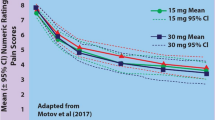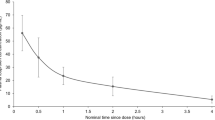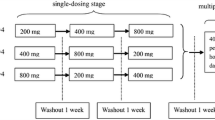Abstract
Intravenous NSAIDs are playing an increasingly large role in analgesia, anti-inflammation and antipyresis in the hospitalized setting. For many years, ketorolac was the only intravenous NSAID available in the US, but in 2009 intravenous ibuprofen was approved by the US FDA for the treatment of pain and fever in adults. In developing intravenous ibuprofen, a range of times of infusion and dosing levels have been utilized and compared with the oral route of administration. The earliest studies utilized a 60-minute infusion, and later a 30-minute infusion was used for the pivotal/registration studies demonstrating efficacy and safety. Another recent trial in healthy volunteers demonstrated a safe and tolerable rapid infusion (5–7 minute) of intravenous ibuprofen. The pharmacokinetic data from all of the clinical trials on 400 and 800 mg doses of intravenous ibuprofen were compiled, and pharmacokinetic modelling was utilized to simulate any data not acquired in the clinical studies. The pharmacokinetic profile of the following doses was modelled: 30-minute infusion of 800 mg intravenous ibuprofen, 5- to 7-minute infusion of 400 mg intravenous ibuprofen and 400 mg ibuprofen oral tablet. These pharmacokinetic analyses revealed that, in general, maximum plasma concentration (Cmax) decreases considerably as the length of the infusion increases and that an oral dose is not able to achieve the Cmax level of any intravenous dose. For the rapid infusion, Cmax was twice that of the oral dose and, as expected, time to Cmax (tmax) was much more rapid than with the oral dose. However, the oral dose still maintained virtually 100% oral bioavailability. The efficacy of intravenous ibuprofen in terms of pain and fever has also been studied and this review found the drug to be efficacious for both indications. Future areas of study should include assessment of the analgesic and antipyretic efficacy of a rapid (5- to 10-minute) infusion and further assessment of pre-emptive administration of intravenous ibuprofen as part of a multimodal analgesic approach in the surgical setting.




Similar content being viewed by others
References
Caldolor (ibuprofen) injection prescribing information. Nashville (TN): Cumberland Pharmaceuticals Inc., 2009
Bernard GR, Wheeler AP, Russell JA, et al. The effects of ibuprofen on the physiology and survival of patients with sepsis. The Ibuprofen in Sepsis Study Group. N Engl J Med 1997 Mar 27; 336(13): 912–8
Southworth S, Peters J, Rock A, et al. A multicenter, randomized, double-blind, placebo-controlled trial of intravenous ibuprofen 400 and 800 mg every 6 hours in the management of postoperative pain. Clin Ther 2009 Sep; 31(9): 1922–35
Kroll PB, Meadows L, Rock A, et al. A multicenter, randomized, double-blind, placebo-controlled trial of intravenous ibuprofen (i.v.-ibuprofen) in the management of postoperative pain following abdominal hysterectomy. Pain Pract 2011 Jan–Feb; 11(1): 23–32
Singla N, Rock A, Pavliv L. A multi-center, randomized, double-blind placebo-controlled trial of intravenousibuprofen (IV-ibuprofen) for treatment of pain in postoperative orthopedic adult patients. Pain Med 2010 Aug; 11(8): 1284–93
Morris PE, Promes JT, Guntupalli KK, et al. A multicenter, randomized, double-blind, parallel, placebo-controlled trial to evaluate the efficacy, safety, and pharmacokinetics of intravenous ibuprofen for the treatment of fever in critically ill and non-critically ill adults. Crit Care 2010; 14(3): R125
Krudsood S, Tangpukdee N, Wilairatana P, et al. Intravenous ibuprofen (IV-ibuprofen) controls fever effectively in adults with acute uncomplicated Plasmodium falciparum malaria but prolongs parasitemia. Am J Trop Med Hyg 2010 Jul; 83(1): 51–5
Pavliv L, Voss B, Rock A. Pharmacokinetics, safety, and tolerability of a rapid infusion of i.v. ibuprofen in healthy adults. Am J Health Syst Pharm 2011 Jan 1; 68(1): 47–51
Promes JT, Safcsak K, Pavliv L, et al. A prospective, multicenter, randomized, double-blind trial of IV ibuprofen for treatment of fever and pain in burn patients. J Burn Care Res 2011 Jan–Feb; 32(1): 79–90
Bookstaver PB, Miller AD, Rudisill CN, et al. Intravenous ibuprofen: the first injectable product for the treatment of pain and fever. J Pain Res 2010; 3: 67–79
Data on file, Cumberland Pharmaceuticals Inc., 2011 Mar 30
Trotman RL, Williamson JC, Shoemaker DM, et al. Antibiotic dosing in critically ill adult patients receiving continuous renal replacement therapy. Clin Infect Dis 2005 Oct 15; 41(8): 1159–66
Davies NM. Clinical pharmacokinetics of ibuprofen: the first 30 years. Clin Pharmacokinet 1998 Feb; 34(2): 101–54
Martin W, Koselowske G, Toberich H, et al. Pharmacokinetics and absolute bioavailability of ibuprofen after oral administration of ibuprofen lysine in man. Biopharm Drug Dispos 1990 Apr; 11(3): 265–78
Cumberland Pharmaceuticals. Surveillance trial to evaluate a shortened infusion time of intravenous ibuprofen [ClinicalTrials.gov identifier NCT01334944]. US National Institutes of Health, ClinicalTrials.gov [online]. Available from URL: http://www.clinicaltrials.gov [Accessed 2012 Jan 11]
Cumberland Pharmaceuticals. Surgical surveillance trial to evaluate a shortened infusion time of intravenous ibuprofen [ClinicalTrials.gov identifier NCT01334957]. US National Institutes of Health, ClinicalTrials.gov [online]. Available from URL: http://www.clinicaltrials.gov [Accessed 2012 Jan 11]
St. Barnabas Medical Center. Does preoperative caldolor decrease the requirement for postoperative narcotics [ClinicalTrials.gov identifier NCT01297829]. US National Institutes of Health, ClinicalTrials.gov [online]. Available from URL: http://www.clinicaltrials.gov [Accessed 2012 Jan 10]
University of Medicine and Dentistry New Jersey. IV ibuprofen for post-electroconvulsive therapy myalgia [ClinicalTrials.gov identifier NCT01200069]. US National Institutes of Health, ClinicalTrials.gov [online]. Available from URL: http://www.clinicaltrials.gov [Accessed 2012 Jan 10]
Thomas Jefferson University. A double-blind, placebo-controlled pilot study to collect and evaluate data on the use of intravenous ibuprofen in the treatment of an acute migraine attack [ClinicalTrials.gov identifier NCT01230411]. US National Institutes of Health, ClinicalTrials.gov [online]. Available from URL: http://www.clinicaltrials.gov [Accessed 2012 Jan 10]
Cumberland Pharmaceuticals. Safety and efficacy of intravenous ibuprofen for treatment of pain in pediatric patients undergoing tonsillectomy [ClinicalTrials.gov identifier NCT01332253]. US National Institutes of Health, ClinicalTrials.gov [online]. Available from URL: http://www.clinicaltrials.gov [Accessed 2012 Jan 10]
Woolf CJ, Chong MS. Preemptive analgesia: treating postoperative pain by preventing the establishment of central sensitization. Anesth Analg 1993 Aug; 77(2): 362–79
Kissin I. Preemptive analgesia: why its effect is not always obvious. Anesthesiology 1996 May; 84(5): 1015–9
Ong CK, Lirk P, Seymour RA, et al. The efficacy of preemptive analgesia for acute postoperative pain management: a meta-analysis. Anesth Analg 2005 Mar; 100(3): 757–73
Duellman TJ, Gaffigan C, Milbrandt JC, et al. Multi-modal, pre-emptive analgesia decreases the length of hospital stay following total joint arthroplasty. Orthopedics 2009 Mar; 32(3): 167
Cumberland Pharmaceuticals. Safety, efficacy, and pharmacokinetic study of intravenous ibuprofen in pediatric patients [ClinicalTrials.gov identifier NCT01002573]. US National Institutes of Health, ClinicalTrials.gov [online]. Available from URL: http://www.clinicaltrials.gov [Accessed 2012 Jan 11]
Laska EM, Sunshine A, Marrero I, et al. The correlation between blood levels of ibuprofen and clinical analgesic response. Clin Pharmacol Ther 1986 Jul; 40(1): 1–7
Olson NZ, Otero AM, Marrero I, et al. Onset of analgesia for liquigel ibuprofen 400 mg, acetaminophen 1000 mg, ketoprofen 25 mg, and placebo in the treatment of postoperative dental pain. J Clin Pharmacol 2001 Nov; 41(11): 1238–47
Packman B, Packman E, Doyle G, et al. Solubilized ibuprofen: evaluation of onset, relief, and safety of a novel formulation in the treatment of episodic tension-type headache. Headache 2000 Jul–Aug; 40(7): 561–7
Daniels S, Reader S, Berry P, et al. Onset of analgesia with sodium ibuprofen, ibuprofen acid incorporating poloxamer and acetaminophen: a single-dose, double-blind, placebo-controlled study in patients with postoperative dental pain. Eur J Clin Pharmacol 2009 Apr; 65(4): 343–53
Kauffman RE, Nelson MV. Effect of age on ibuprofen pharmacokinetics and antipyretic response. J Pediatr 1992 Dec; 121(6): 969–73
Kelley MT, Walson PD, Edge JH, et al. Pharmacokinetics and pharmacodynamics of ibuprofen isomers and acetaminophen in febrile children. Clin Pharmacol Ther 1992 Aug; 52(2): 181–9
Nielsen JC, Bjerring P, Arendt-Nielsen L, et al. A double-blind, placebo controlled, cross-over comparison of the analgesic effect of ibuprofen 400 mg and 800 mg on laser-induced pain. Br J Clin Pharmacol 1990 Nov; 30(5): 711–5
Ceppi Monti N, Gazzaniga A, Gianesello V, et al. Activity and pharmacokinetics of a new oral dosage form of soluble ibuprofen. Arzneimittel-Forschung 1992 Apr; 42(4): 556–9
Aronoff DM, Neilson EG. Antipyretics: mechanisms of action and clinical use in fever suppression. Am J Med 2001 Sep; 111(4): 304–15
Grosser T, Smyth E, FitzGerald GA. Anti-Inflammatory, Antipyretic, and Analgesic Agents;Pharmacotherapy of Gout. In: Brunton L, Chabner B, Knollman B. Goodman & Gilman’s the pharmacological basis of therapeutics. 12th ed. Columbus (OH): McGraw-Hill Companies, Inc., 2011: 959–1004
Warner TD, Giuliano F, Vojnovic I, et al. Nonsteroid drug selectivities for cyclo-oxygenase-1 rather than cyclo-oxygenase-2 are associated with human gastrointestinal toxicity: a full in vitro analysis. Proc Natl Acad Sci U S A 1999 Jun 22; 96(13): 7563–8
Acknowledgements
Bryan Voss, PhD, is an employee of Cumberland Pharmaceuticals Inc., which manufactures, and is conducting trials on, intravenous ibuprofen. As an employee, Dr Voss also holds stock/stock options.
No external sources of funding were used to conduct this study or prepare this manuscript. Dr Smith has no conflicts of interest that are directly relevant to the content of this article.
Author information
Authors and Affiliations
Corresponding author
Rights and permissions
About this article
Cite this article
Smith, H.S., Voss, B. Pharmacokinetics of Intravenous Ibuprofen. Drugs 72, 327–337 (2012). https://doi.org/10.2165/11599230-000000000-00000
Published:
Issue Date:
DOI: https://doi.org/10.2165/11599230-000000000-00000




